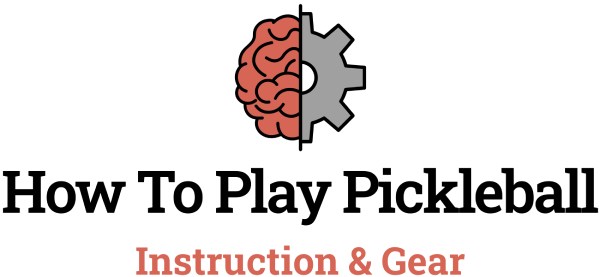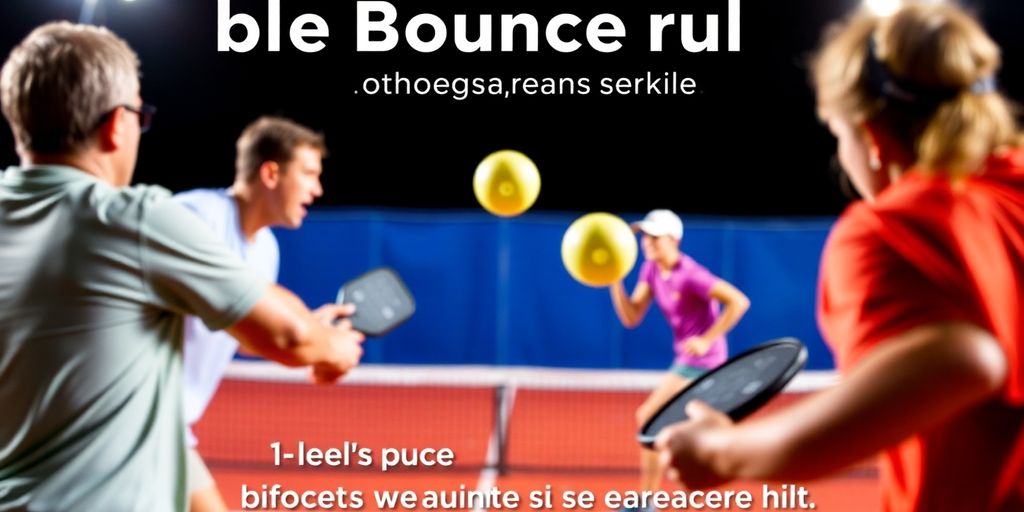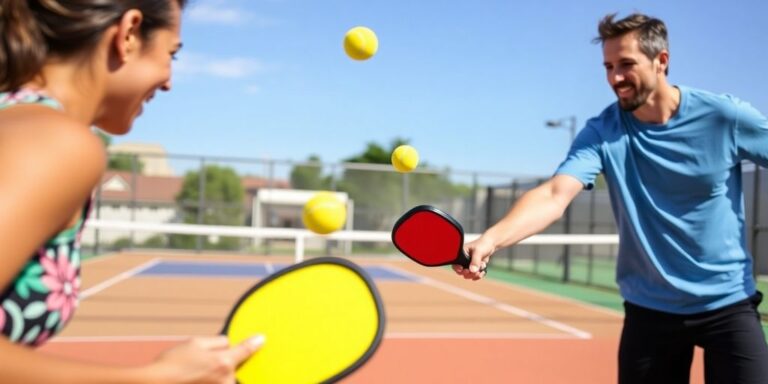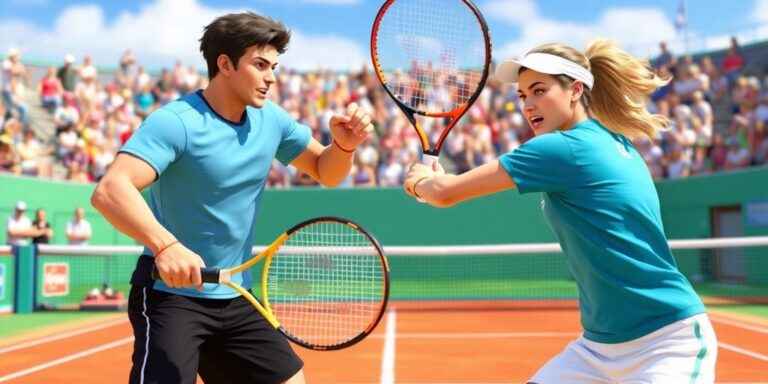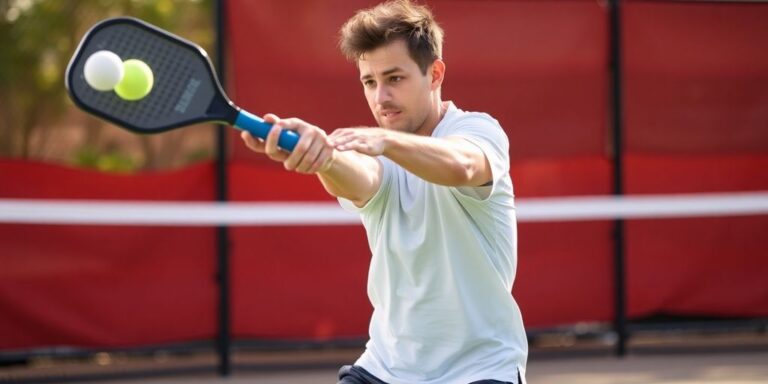Pickleball is a sport that’s gaining popularity fast, blending elements from tennis, badminton, and table tennis. One key rule that sets it apart is the Double Bounce Rule. Understanding this rule is essential for anyone looking to play effectively, whether you’re just starting out or have been playing for a while. It not only helps maintain fairness but also adds a layer of strategy to the game that can enhance your overall experience on the court.
Key Takeaways
- The Double Bounce Rule requires the ball to bounce once on each side before players can volley.
- This rule promotes fairness by leveling the playing field between servers and receivers.
- It encourages longer rallies, making the game more exciting and engaging.
- Players must adjust their strategies based on the mandatory bounces to improve their gameplay.
- Understanding this rule is crucial for both new and experienced players to enhance their skills.
Understanding The Double Bounce Rule
The double bounce rule is one of those things that makes pickleball unique. It’s not just some random quirk; it really shapes how the game is played. It’s pretty simple, but understanding it is key, whether you’re just starting out or you’ve been playing for years. It’s a fundamental regulation that sets the stage for each point.
Definition of the Double Bounce Rule
Okay, so what is the double bounce rule? Basically, after the serve, the ball has to bounce once on the receiver’s side, and then, after the return, it has to bounce once on the server’s side before anyone can start volleying. This means no smashing the serve right back or rushing the net to cut off the return. It forces a bit of patience and sets up the rally.
How the Rule is Applied
It’s pretty straightforward. The server serves. The ball bounces on the receiving side. The receiver hits it back. The ball bounces on the serving side. Then the fun begins. After those two bounces, anyone can volley. If you mess up and volley too early, you lose the point. It applies to both singles and doubles, no exceptions. It’s all about fair play and giving each side a chance to get into position.
Key Components of the Rule
There are a few things to keep in mind about this rule:
- It only applies to the first two shots of the point.
- It’s the same in singles and doubles.
- There are no exceptions – you have to let it bounce.
The double bounce rule is more than just a rule; it’s a strategic element. It slows down the initial pace, encourages groundstrokes, and gives players time to think about their next move. It also promotes safety by preventing players from crowding the net too early. It’s a comprehensive guide to understanding the game’s dynamics.
Importance of The Double Bounce Rule
The double bounce rule? It’s not just some weird quirk of pickleball. It actually does a lot to make the game better for everyone. It’s easy to take for granted, but think about how different the game would be without it. It’s a pretty big deal.
Promoting Fair Play
The double bounce rule is a big part of what makes pickleball fair. Without it, the serving team would have a huge advantage. Imagine if they could just blast the ball over the net and immediately start volleying. It would be super hard to return, right? This rule forces both teams to let the ball bounce, which gives the receiving team a chance to get into the point. It levels the playing field, especially for beginners who might not have the reflexes to handle aggressive net play right away. It’s all about giving everyone a fair shot.
Encouraging Longer Rallies
The double bounce rule is a rally extender. It stops players from ending points super quickly with aggressive volleys right off the bat. This means you get more back-and-forth action, which is way more fun for everyone involved. It also means you have to develop better groundstrokes and court positioning, because you can’t just rely on quick reactions at the net. It makes for a more strategic and engaging game overall. Think of it as the rule that keeps the game interesting.
Enhancing Game Strategy
This rule forces you to think about your shots and positioning more carefully. You can’t just rush the net and try to smash everything. You have to plan your attack, anticipate your opponent’s moves, and use groundstrokes effectively. It adds a layer of depth to the game that wouldn’t be there otherwise. It’s not just about power; it’s about strategy and finesse. Understanding doubles in pickleball is key to mastering this aspect.
The double bounce rule really changes how you approach the game. It makes you think more about placement and strategy, rather than just trying to overpower your opponent. It’s a rule that rewards patience and smart play.
Here’s a quick look at how it affects strategy:
- Forces players to develop groundstrokes.
- Encourages strategic court positioning.
- Promotes patience and thoughtful shot selection.
- Reduces the server’s advantage, leading to more balanced gameplay.
It’s a simple rule, but it has a big impact on how the game is played. It’s what makes pickleball, well, pickleball. And understanding pickleball in singles format is just as important.
How The Double Bounce Rule Affects Gameplay

Impact on Game Dynamics
The double bounce rule really changes how pickleball is played. It forces a slower start to each point. This gives players more time to think about their next move, instead of just reacting super fast. It’s not just about reflexes; it’s about strategy. This rule makes the game more approachable for beginners because it’s not all about power right from the start. It also adds depth for more experienced players, who can use the initial bounces to set up complex plays.
The double bounce rule also makes the game safer. It stops players from rushing the net too soon, which could lead to collisions or injuries. By making sure the ball bounces on each side before anyone can volley, it keeps a safer distance between players during those first important shots.
Influence on Player Strategy
The double bounce rule pushes players to develop good groundstrokes. Since you can’t just rush the net and volley right away, you need to be able to hit solid shots off the bounce. This means working on your technique and learning how to control the ball. Players need to think about where they’re standing and how they’re going to hit the ball after the bounce. It’s not just about hitting it hard; it’s about placing it well and setting up your next shot. Here are some strategic considerations:
- Serve Placement: Aiming for deep serves or serves that are difficult to return.
- Return Strategy: Using the return to gain court position or force a weak shot.
- Patience: Waiting for the right opportunity to approach the net.
Effects on Rally Length
The double bounce rule tends to make rallies longer. Because players can’t volley right away, there are more opportunities for back-and-forth play. This means more chances to show off your skills and wear down your opponent. Longer rallies also mean more strategic play, as players try to outmaneuver each other and create openings. It’s not just about hitting winners; it’s about building points and playing smart. The rule promotes a more measured and thoughtful game, where patience and strategy can be as important as power. The initial exchange is critical to setting up the rally and ensures a level playing field.
Mastering The Double Bounce Rule
Drills for Practicing the Rule
Okay, so you want to get better at the double bounce rule? It’s all about practice, practice, practice. One drill I found super helpful is the "Controlled Rally Practice." Basically, you and a partner just focus on serving and returning, making sure you let the ball bounce each time. Don’t worry about winning the point; just focus on control and positioning. Another good one is "Serve and Return Accuracy." Try to place your shots in tough spots for your opponent after the bounce. This helps you get used to thinking strategically about where the ball will be and how to react. Here’s a quick rundown:
- Controlled Rally Practice: Focus on consistent bounces and positioning.
- Serve and Return Accuracy: Aim for difficult shot placement.
- Strategic Positioning: Adjust your position after each shot.
Tips for New Players
If you’re new to pickleball, the double bounce rule can seem a little weird at first. The most important thing to remember is that both sides have to let the ball bounce once after the serve and return before volleying. Don’t rush to the net right away! Use that extra time to think about your next move and get into a good position. Also, don’t be afraid to ask questions. Most pickleball players are happy to help beginners learn the ropes. Here are a few quick tips:
- Be patient; don’t rush to the net.
- Communicate with your partner.
- Focus on consistent groundstrokes.
The double bounce rule is there to make the game fairer and more fun for everyone. It gives you a chance to get into position and think about your strategy before the volleying starts. Don’t see it as a restriction; see it as an opportunity.
Improving Shot Selection
Shot selection becomes super important when you’re trying to master the double bounce rule. You need to think about where you’re placing the ball and how it will bounce. For example, a good dink shot can force your opponent to hit up, giving you an advantage. Also, pay attention to your opponent’s position. If they’re deep in the court, a drop shot might be a good option. Here are some things to consider:
- Consider the bounce angle.
- Anticipate your opponent’s move.
- Mix up your shots to keep them guessing.
Understanding the pickleball rules is key to improving your game.
Common Misunderstandings About The Double Bounce Rule

Clarifying Misconceptions
It’s easy to get tripped up on the double bounce rule, especially when you’re new to pickleball. One common mistake is thinking the rule only matters at the start of the game. Actually, it applies at the beginning of every single point. Once those initial bounces are out of the way, then you can start volleying (unless you’re chilling in the non-volley zone, of course!).
Another thing people sometimes mix up is whether the rule changes between singles and doubles. Nope! It’s the same, no matter how many people are on the court. The essential rules of pickleball are consistent across all game types.
Exceptions to the Rule
Honestly, there aren’t really any exceptions to the double bounce rule. It’s pretty cut and dry. No matter how crazy the serve is, or how wild the return, that ball has to bounce on each side before anyone starts volleying. Trying to bend the rules just leads to arguments and nobody wants that. It’s there to avoid common mistakes and keep things fair.
Understanding Its Application in Doubles
Doubles can get a little confusing because you’ve got two people trying to figure out who’s getting the return. Here’s the deal:
- Communication is key. Talk to your partner! Decide beforehand who’s taking the shot.
- Don’t assume. Just because you think your partner’s got it doesn’t mean they do.
- If you both go for it, someone’s gonna mess up. And it’s probably gonna be you.
The double bounce rule in doubles is all about teamwork. If you and your partner aren’t on the same page, you’re going to lose points. Work together, call the shots, and make sure someone’s ready to let that ball bounce before making a play.
Strategies for Leveraging The Double Bounce Rule
Positioning After Bounces
Where you stand after those initial bounces can really change the game. It’s all about finding that sweet spot where you can handle a groundstroke but also be ready to move up to the kitchen line for a volley. Think of it as a balancing act. You don’t want to be caught too far back, but you also don’t want to jump the gun and end up in the non-volley zone before you’re allowed. It’s a dance, really. Understanding the double bounce rule is key to mastering this positioning.
Communication in Doubles
In doubles, talking to your partner is super important, especially during that double bounce phase. Call out who’s got the return, discuss where you’re moving, and plan your next shot together. A simple "I got it!" or "Yours!" can prevent confusion and keep you both on the same page. Good communication can turn a potentially bad situation into a strategic advantage. It’s about teamwork, plain and simple. Effective communication is a cornerstone of doubles in pickleball.
Transitioning to Aggressive Play
The double bounce rule isn’t just about defense; it’s also a setup for offense. Once those mandatory bounces are out of the way, it’s time to get aggressive. Look for opportunities to move forward, control the net, and put pressure on your opponents. The initial bounces give you a chance to assess the situation and plan your attack. Don’t be afraid to take charge and dictate the pace of the game. This transition is where you can really master pickleball.
The double bounce rule is more than just a starting point; it’s a strategic element that can be used to control the flow of the game. By understanding how to position yourself, communicate with your partner, and transition to aggressive play, you can turn this rule into a powerful weapon on the court.
The Role of The Double Bounce Rule in Player Development
The double bounce rule isn’t just some weird quirk of pickleball; it’s actually pretty important for how players learn and get better at the game. It affects everything from basic skills to how you think about strategy. It’s a big deal, especially when you’re starting out.
Building Fundamental Skills
The double bounce rule forces you to develop solid groundstrokes. You can’t just rush the net and smash everything. You actually have to learn to hit the ball after it bounces, which means working on your technique and footwork. This builds a strong base for more advanced play later on.
Here’s a quick breakdown of how it helps:
- Better groundstroke technique
- Improved footwork and court coverage
- More consistent shot placement
Encouraging Patience and Strategy
The double bounce rule slows things down a bit. You can’t just blast the ball back immediately. This gives you time to think about your next move and plan your attack. It teaches you to be patient and to think strategically about shot selection instead of just reacting. It’s like a chess game, but with paddles and a wiffle ball.
The double bounce rule really makes you think about where you’re standing and where you want the ball to go. It’s not just about hitting it hard; it’s about hitting it smart. This is especially true in doubles, where communication and positioning are key.
Fostering Competitive Play
By leveling the playing field at the start of each point, the double bounce rule makes the game more competitive. It prevents experienced players from dominating with aggressive serves and volleys right away. This gives newer players a chance to get into the rally and develop their skills. It also makes longer rallies more common, which is more fun for everyone involved. It also helps to avoid common mistakes.
Here’s how it helps:
- More balanced matches
- Increased opportunity for skill development
- More exciting and unpredictable games
Basically, the double bounce rule is a key part of what makes pickleball such a great sport for players of all levels. It’s not just a rule; it’s a tool for learning and growing as a player. It encourages fair play and helps players develop singles play strategies.
The Double Bounce Rule is an important part of how players grow and improve in their game. This rule helps players learn to react quickly and think strategically. By practicing with this rule, players can develop better skills and become more confident on the court. If you want to learn more about how this rule can help you or your team, visit our website for tips and resources!
Wrapping It Up
In conclusion, the Double Bounce Rule is a big deal in pickleball. It’s not just a rule; it shapes how the game is played. By making sure the ball bounces on both sides before players can volley, it levels the playing field and encourages longer rallies. This rule helps players think strategically and gives everyone a fair shot at the game. Whether you’re just starting out or you’ve been playing for a while, understanding this rule can really change how you approach your matches. So, next time you hit the court, keep the double bounce rule in mind—it might just give you the edge you need.
Frequently Asked Questions
What is the Double Bounce Rule in pickleball?
The Double Bounce Rule states that the ball must bounce once on each side of the net before players can hit it in the air. This rule starts at the beginning of each point.
Why is the Double Bounce Rule important?
This rule is important because it helps create longer rallies and fair play. It gives both players a chance to react and strategize before hitting the ball.
How does the Double Bounce Rule change gameplay?
The Double Bounce Rule makes the game slower at first, allowing players to think about their next move. It can also lead to more exciting rallies.
What should new players know about the Double Bounce Rule?
New players should practice allowing the ball to bounce once on each side before hitting it. This will help them get comfortable with the game’s flow.
Are there any exceptions to the Double Bounce Rule?
There are no exceptions; the rule must be followed every time a point starts. Both singles and doubles players must let the ball bounce once on each side.
How can players use the Double Bounce Rule to their advantage?
Players can use the rule to set up their shots better and create opportunities to place the ball where their opponent may struggle to return it.
